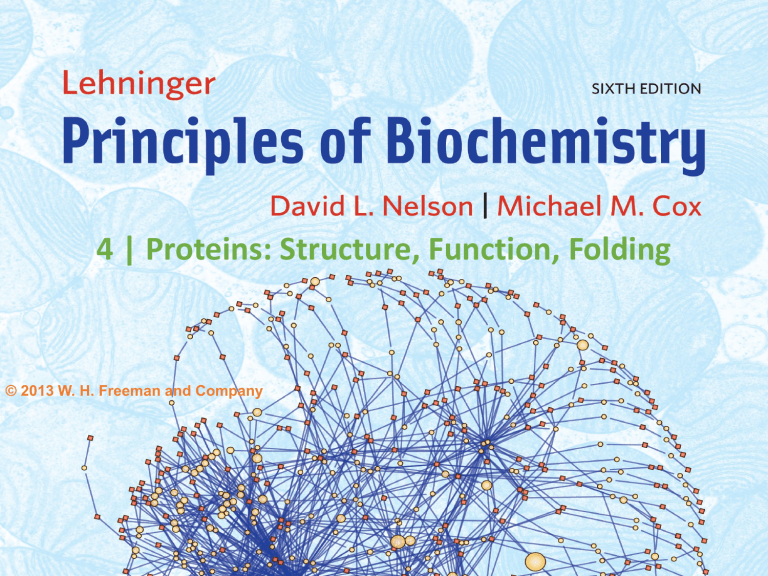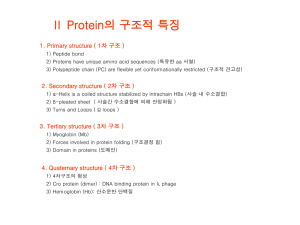Protein Structure, Function, and Folding: Biochemistry Slides
advertisement

4 | Proteins: Structure, Function, Folding © 2013 W. H. Freeman and Company CHAPTER 4 Lesson 1 – General aspects of protein structure – The importance of non-covalent interactions in protein structure – Main characteristics and properties of the peptide bond – Ramachandran plots Proteins: Main Agents of Biological Function • Catalysis – enolase (in the glycolytic pathway) – DNA polymerase (in DNA replication) • Transport – hemoglobin (transports O2 in the blood) – lactose permease (transports lactose across the cell membrane) • Structure – collagen (connective tissue) – keratin (hair, nails, feathers, horns) • Motion – myosin (muscle tissue) – actin (muscle tissue, cell motility) “Protein” • • • • • One or more polypeptide chains One polypeptide chain - a monomeric protein More than one polypeptide chain- multisubunit/ multimeric protein (units α, β, γ…) Subunits are identical-homomeric Subunits are different-heteromeric At least two of the subunits are the same oligomeric and the subunits are known as protomers Proteins frequently contain other groups in their structures • Polypeptides (covalently linked α-amino acids) + possibly: cofactors : required for protein activity, lightly bounded − functional non-amino acid component − can be metal ions or organic molecules • coenzymes : required for enzyme activity − organic cofactors − ex: NAD+ in lactate dehydrogenase • prosthetic groups − Covalently/tightly attached non-amino acid cofactors/coenzyme • other modifications: amino acids may have post translational or reversible modifications • Classes of Conjugated Proteins Describing Hemoglobin • Four subunits • Heterotetrameric • Two different chains/ protomers (α and β) • two alpha oligomers /chains and two beta oligomers/chains 2α2β • Prosthetic group: heme • Conjugated protein: hemoprotein https://upload.wikimedia.org/wikipedia/common s/thumb/3/3d/1GZX_Haemoglobin.png/800px1GZX_Haemoglobin.png 4 Levels of Protein Structure Structure of Proteins • Unlike most organic polymers, protein molecules adopt a specific three-dimensional conformation. • This structure gives the protein the ability to fulfill a specific biological function • This structure is called the native fold • The native fold has a large number of favorable interactions within the protein • There is a cost in conformational entropy of folding the protein into one specific native fold Favorable Interactions in Proteins • Hydrophobic effect – Release of water molecules from the structured solvation layer around the molecule as protein folds increases the net entropy • Hydrogen bonds – Interaction of N-H and C=O of the peptide bond leads to local regular structures such as α-helices and β-sheets • London dispersion – Medium-range weak attraction between all atoms contributes significantly to the stability in the interior of the protein • Electrostatic interactions – Long-range strong interactions between permanently charged groups – Salt-bridges, esp. buried in the hydrophobic environment strongly stabilize the protein • Disulfide bridges Peptide bond formation Structure of the Peptide Bond • Structure of the protein is partially dictated by the properties of the peptide bond • Compared to a simpler amide, peptide bonds: – to be quite rigid and nearly planar – to exhibit a large dipole moment in the favored trans configuration • The peptide bond is a resonance hybrid of two canonical structures Resonance in the Peptide Bond The polypeptide is made up of a series of planes linked at α carbons The Rigid Peptide Plane and the Partially Free Rotations • Rotation around the peptide bond is not permitted • Rotation around bonds connected to the alpha carbon is permitted • φ (phi): angle around the α-carbon—amide nitrogen bond • ψ (psi): angle around the α-carbon—carbonyl carbon bond • In a fully extended polypeptide, both ψ and φ are 180° Distribution of φ and ψ Dihedral Angles • Some φ and ψ combinations are very unfavorable because of steric crowding of backbone atoms with other atoms in the backbone or side chains • Some φ and ψ combinations are more favorable because of chance to form favorable H-bonding interactions along the backbone • A Ramachandran plot shows the distribution of φ and ψ dihedral angles that are found in a protein • shows the common secondary structure elements • reveals regions with unusual backbone structure Ramachandran Plot Formation of peptide bonds Which functional groups are used by α-amino acids to form the peptide bond? a. Hydroxyl and amino b. α-Carboxylic acid and hydroxyl c. α-Carboxylic acid and α-amino d. Carboxylic acid and amino Conformation of the peptide bond The number of conformations found for the peptide bond is limited to the cis or trans conformations due to: a. The number of amino acids in the peptide or protein b. The formation of hydrogen bonding c. Restricted rotation around the peptide bond d. Steric hinderance e. All of the above Dihedral angles in peptides The set of admissible values of the dihedral angles φ (phi) and ψ (psi) in found naturally in peptides and proteins is limited due to: a. The number of amino acids in the peptide or protein b. The formation of hydrogen bonding c. Restricted rotation around the peptide bond d. Steric crowding e. All of the above




